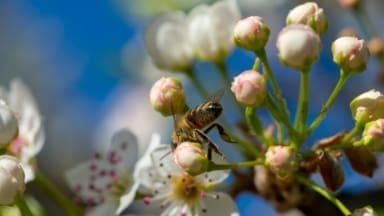
Whether insect-pollinated or wind-pollinated, flowering or cone-bearing, trees are key for pollinators and have a much larger footprint in our landscapes than flower beds or meadows. The Trees for bees project, aims to identify which trees at Wakehurst are most effective for supporting diverse populations of bees and other insects, like wasps, butterflies and moths.
Whilst there have been many studies over the years focusing on pollinators, very few have looked at the value of trees within pollinator communities. Wakehurst scientists is calling out to citizens to count the insects that are visiting flowering or pollen producing trees to help collect essential data – to help find solutions to environmental changes.
The study will consider which trees are most effective at reducing the impact of heavy rainfall and pollution, promoting human wellbeing, keeping cities cooler and providing shade. As well as which trees enhance biodiversity by supplying vital resources for insects that are not pollinators.
The project is part of the pollination research stream of Wakehurst’s Nature Unlocked pollinator science programme. It investigates which species of tree are the best for a diverse range of pollinators.
Dr Janine Griffiths-Lee, Postdoctoral Research Associate at Wakehurst said: “Many studies on habitat management for pollinators focus on wildflowers and agricultural landscapes. In our urban centres where space is limited and there isn’t room for swathes of meadows, we could plant a diverse range of tree species that take up less space. They’d be like 3-dimensional sky meadows and provide lots of pollen and nectar to our pollinators. But to inform landscape planning we first need to find out which are the best trees to plant, and that’s what this project is all about.”
The Trees for Bees project is open to all who wish to take part. Instructions are provided in the Wakehurst citizen science guide (provided at the Visitor Centre or downloadable), and there is a dedicated Trees for bees app to record findings.

